Investment Appraisal: Capital Budgeting and ROI Analysis Report
VerifiedAdded on 2023/06/13
|9
|1825
|76
Report
AI Summary
This report provides a comprehensive analysis of capital budgeting and investment appraisal techniques, essential for businesses in selecting optimal investment projects. It explores various appraisal methods, including Net Present Value (NPV), Accounting Rate of Return (ARR), Internal Rate of Return (IRR), and Payback Period, detailing their strengths and weaknesses. The report applies these techniques to a case involving Project A20 and Project B25, ultimately recommending Project A20 based on its superior NPV, shorter payback period, and higher IRR. Furthermore, it justifies the finance director's confidence in achieving an IRR above 7% for both projects, citing positive NPVs, high average rates of return, and industry benchmarks. The conclusion emphasizes the importance of informed project selection for long-term financial profitability and provides guidance for managers, investors, and analysts in evaluating investment proposals and understanding company positioning.
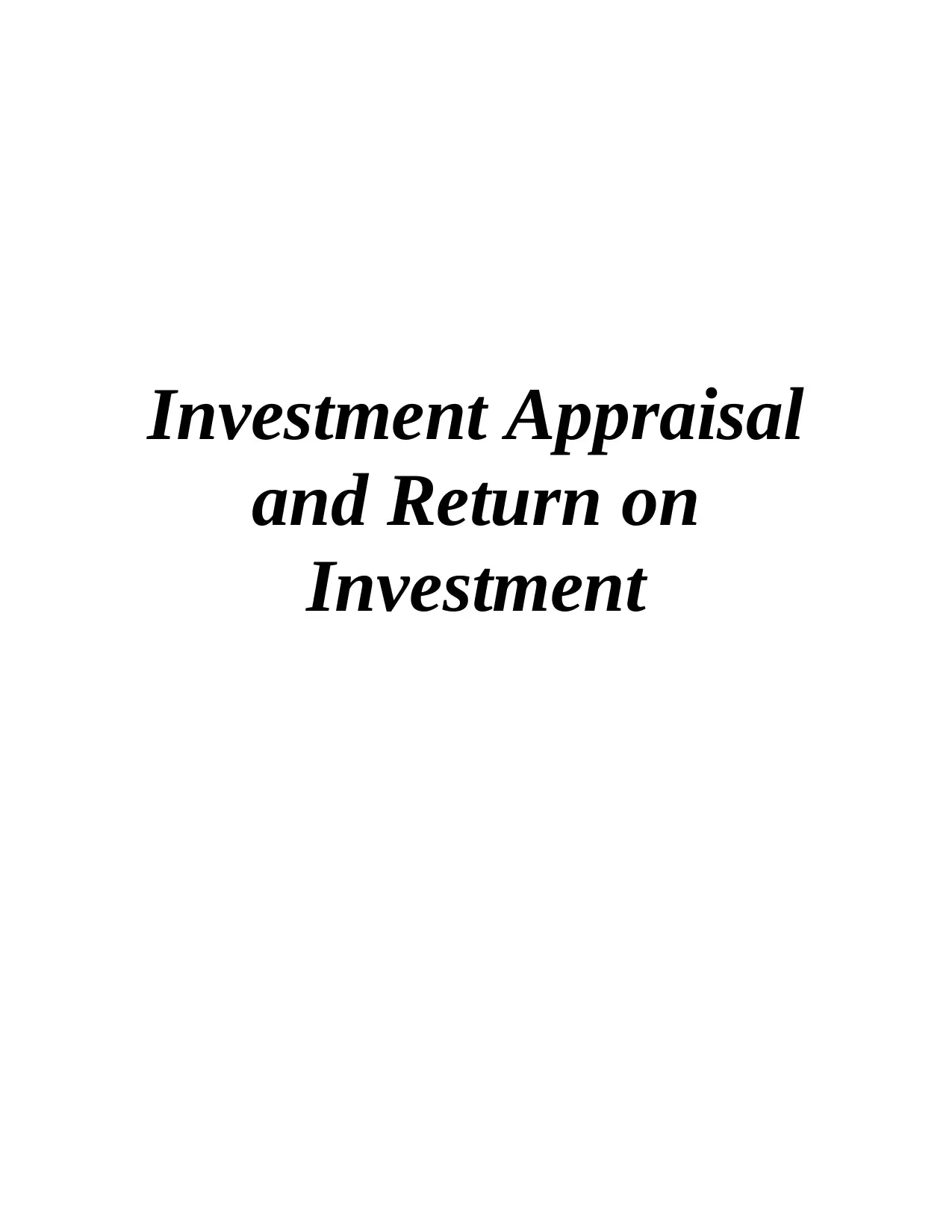
Investment Appraisal
and Return on
Investment
and Return on
Investment
Paraphrase This Document
Need a fresh take? Get an instant paraphrase of this document with our AI Paraphraser

Table of Contents
INTRODUCTION ..........................................................................................................................3
TASK...............................................................................................................................................3
Describe the usefulness of capital investment appraisal measures with strength and
weaknesses.............................................................................................................................3
Recommendations for the project:..........................................................................................4
Define reasons why finance director was so sure that IRR would be more than 7% for both
options....................................................................................................................................5
CONCLUSION ...............................................................................................................................6
REFERENCES................................................................................................................................7
INTRODUCTION ..........................................................................................................................3
TASK...............................................................................................................................................3
Describe the usefulness of capital investment appraisal measures with strength and
weaknesses.............................................................................................................................3
Recommendations for the project:..........................................................................................4
Define reasons why finance director was so sure that IRR would be more than 7% for both
options....................................................................................................................................5
CONCLUSION ...............................................................................................................................6
REFERENCES................................................................................................................................7
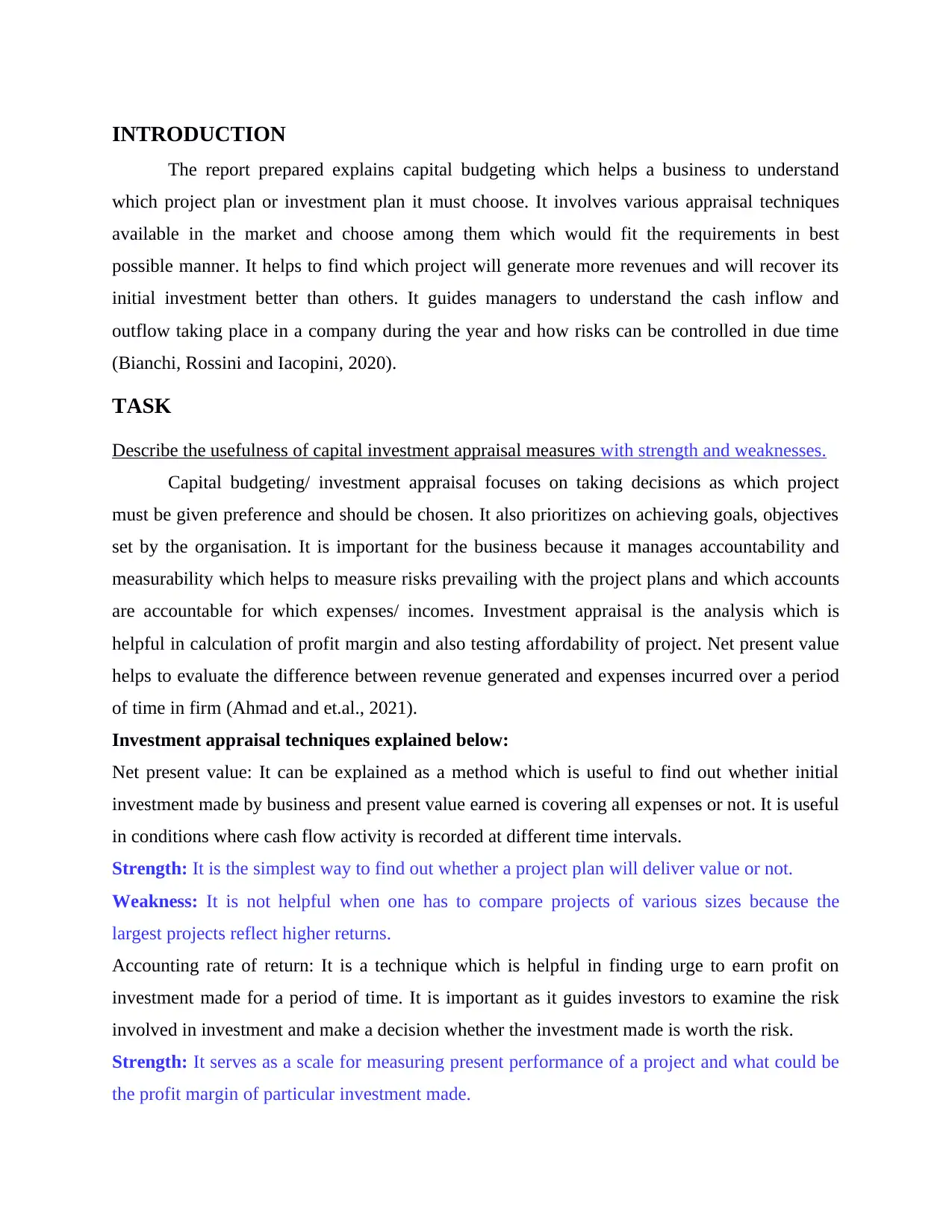
INTRODUCTION
The report prepared explains capital budgeting which helps a business to understand
which project plan or investment plan it must choose. It involves various appraisal techniques
available in the market and choose among them which would fit the requirements in best
possible manner. It helps to find which project will generate more revenues and will recover its
initial investment better than others. It guides managers to understand the cash inflow and
outflow taking place in a company during the year and how risks can be controlled in due time
(Bianchi, Rossini and Iacopini, 2020).
TASK
Describe the usefulness of capital investment appraisal measures with strength and weaknesses.
Capital budgeting/ investment appraisal focuses on taking decisions as which project
must be given preference and should be chosen. It also prioritizes on achieving goals, objectives
set by the organisation. It is important for the business because it manages accountability and
measurability which helps to measure risks prevailing with the project plans and which accounts
are accountable for which expenses/ incomes. Investment appraisal is the analysis which is
helpful in calculation of profit margin and also testing affordability of project. Net present value
helps to evaluate the difference between revenue generated and expenses incurred over a period
of time in firm (Ahmad and et.al., 2021).
Investment appraisal techniques explained below:
Net present value: It can be explained as a method which is useful to find out whether initial
investment made by business and present value earned is covering all expenses or not. It is useful
in conditions where cash flow activity is recorded at different time intervals.
Strength: It is the simplest way to find out whether a project plan will deliver value or not.
Weakness: It is not helpful when one has to compare projects of various sizes because the
largest projects reflect higher returns.
Accounting rate of return: It is a technique which is helpful in finding urge to earn profit on
investment made for a period of time. It is important as it guides investors to examine the risk
involved in investment and make a decision whether the investment made is worth the risk.
Strength: It serves as a scale for measuring present performance of a project and what could be
the profit margin of particular investment made.
The report prepared explains capital budgeting which helps a business to understand
which project plan or investment plan it must choose. It involves various appraisal techniques
available in the market and choose among them which would fit the requirements in best
possible manner. It helps to find which project will generate more revenues and will recover its
initial investment better than others. It guides managers to understand the cash inflow and
outflow taking place in a company during the year and how risks can be controlled in due time
(Bianchi, Rossini and Iacopini, 2020).
TASK
Describe the usefulness of capital investment appraisal measures with strength and weaknesses.
Capital budgeting/ investment appraisal focuses on taking decisions as which project
must be given preference and should be chosen. It also prioritizes on achieving goals, objectives
set by the organisation. It is important for the business because it manages accountability and
measurability which helps to measure risks prevailing with the project plans and which accounts
are accountable for which expenses/ incomes. Investment appraisal is the analysis which is
helpful in calculation of profit margin and also testing affordability of project. Net present value
helps to evaluate the difference between revenue generated and expenses incurred over a period
of time in firm (Ahmad and et.al., 2021).
Investment appraisal techniques explained below:
Net present value: It can be explained as a method which is useful to find out whether initial
investment made by business and present value earned is covering all expenses or not. It is useful
in conditions where cash flow activity is recorded at different time intervals.
Strength: It is the simplest way to find out whether a project plan will deliver value or not.
Weakness: It is not helpful when one has to compare projects of various sizes because the
largest projects reflect higher returns.
Accounting rate of return: It is a technique which is helpful in finding urge to earn profit on
investment made for a period of time. It is important as it guides investors to examine the risk
involved in investment and make a decision whether the investment made is worth the risk.
Strength: It serves as a scale for measuring present performance of a project and what could be
the profit margin of particular investment made.
⊘ This is a preview!⊘
Do you want full access?
Subscribe today to unlock all pages.

Trusted by 1+ million students worldwide
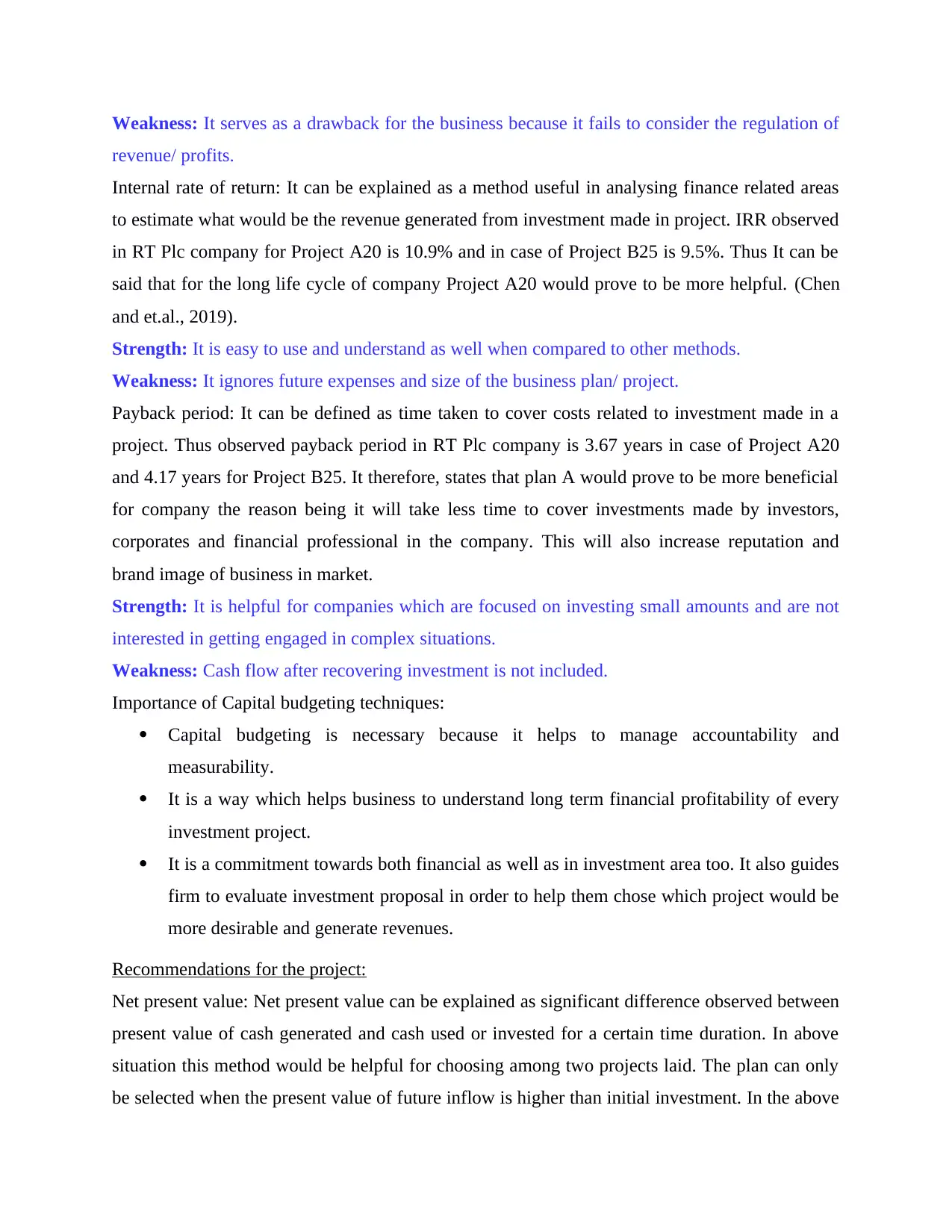
Weakness: It serves as a drawback for the business because it fails to consider the regulation of
revenue/ profits.
Internal rate of return: It can be explained as a method useful in analysing finance related areas
to estimate what would be the revenue generated from investment made in project. IRR observed
in RT Plc company for Project A20 is 10.9% and in case of Project B25 is 9.5%. Thus It can be
said that for the long life cycle of company Project A20 would prove to be more helpful. (Chen
and et.al., 2019).
Strength: It is easy to use and understand as well when compared to other methods.
Weakness: It ignores future expenses and size of the business plan/ project.
Payback period: It can be defined as time taken to cover costs related to investment made in a
project. Thus observed payback period in RT Plc company is 3.67 years in case of Project A20
and 4.17 years for Project B25. It therefore, states that plan A would prove to be more beneficial
for company the reason being it will take less time to cover investments made by investors,
corporates and financial professional in the company. This will also increase reputation and
brand image of business in market.
Strength: It is helpful for companies which are focused on investing small amounts and are not
interested in getting engaged in complex situations.
Weakness: Cash flow after recovering investment is not included.
Importance of Capital budgeting techniques:
Capital budgeting is necessary because it helps to manage accountability and
measurability.
It is a way which helps business to understand long term financial profitability of every
investment project.
It is a commitment towards both financial as well as in investment area too. It also guides
firm to evaluate investment proposal in order to help them chose which project would be
more desirable and generate revenues.
Recommendations for the project:
Net present value: Net present value can be explained as significant difference observed between
present value of cash generated and cash used or invested for a certain time duration. In above
situation this method would be helpful for choosing among two projects laid. The plan can only
be selected when the present value of future inflow is higher than initial investment. In the above
revenue/ profits.
Internal rate of return: It can be explained as a method useful in analysing finance related areas
to estimate what would be the revenue generated from investment made in project. IRR observed
in RT Plc company for Project A20 is 10.9% and in case of Project B25 is 9.5%. Thus It can be
said that for the long life cycle of company Project A20 would prove to be more helpful. (Chen
and et.al., 2019).
Strength: It is easy to use and understand as well when compared to other methods.
Weakness: It ignores future expenses and size of the business plan/ project.
Payback period: It can be defined as time taken to cover costs related to investment made in a
project. Thus observed payback period in RT Plc company is 3.67 years in case of Project A20
and 4.17 years for Project B25. It therefore, states that plan A would prove to be more beneficial
for company the reason being it will take less time to cover investments made by investors,
corporates and financial professional in the company. This will also increase reputation and
brand image of business in market.
Strength: It is helpful for companies which are focused on investing small amounts and are not
interested in getting engaged in complex situations.
Weakness: Cash flow after recovering investment is not included.
Importance of Capital budgeting techniques:
Capital budgeting is necessary because it helps to manage accountability and
measurability.
It is a way which helps business to understand long term financial profitability of every
investment project.
It is a commitment towards both financial as well as in investment area too. It also guides
firm to evaluate investment proposal in order to help them chose which project would be
more desirable and generate revenues.
Recommendations for the project:
Net present value: Net present value can be explained as significant difference observed between
present value of cash generated and cash used or invested for a certain time duration. In above
situation this method would be helpful for choosing among two projects laid. The plan can only
be selected when the present value of future inflow is higher than initial investment. In the above
Paraphrase This Document
Need a fresh take? Get an instant paraphrase of this document with our AI Paraphraser

situation project A20 will be selected because investment made is less than other project but
payback period is observed less than the other project which clearly states that less time will be
required for covering the investment made.
Accounting rate of return: This technique is helpful in finding profitability on long term basis
keeping business concerns in mind. If the profit generated by business is high than the
Accounting rate of return would also rise. When compared with Project A20 it can be observed
that Project B25 is providing higher rate of return which is 15% and thus Project B25 would be
selected.
Payback period: It is defined as a period during which the amount invested in a particular project
is recovered. With the help of this technique it can be analysed that Project A20 took 3.67 years
for covering its investment made in initial stages whereas Project B25 took 4.17 years. Thus it
can be concluded that Project A20 should be selected.
Internal rate of return: This method is useful to have a proper analysis of financial areas which
help to calculate what could be estimated profits of investments made. It also helps to examine
which project gives higher rate of interest on investments made by the business. Thus keeping
this in mind Project A20 is beneficial and must be selected because it generates more return than
Project B25 (Brück, Ludwig and Schwering, 2018).
From the above applied techniques such as Internal rate of return, accounting rate of
return, Net present value it can be said that Project A20 must be selected from the point of NPV
because it is given more priority than any other project. Project A20 is providing positive Net
present value, Payback period observed for Project A is 3.67 years which is less than Project B25
that is 4.17 years. Internal rate of return is 10.9% in case of Project A20 whereas 9.5% in case of
Project B25. Thus it is evident that Project A20 will prove itself to be more worthy than other
project. NPV has been selected because it includes all future related aspects and gives a better,
more clear and transparent picture of the activities performed in a certain project. It provides a
idea to managers and experts whether to invest in a project or not. Whether a project will reflect
positive figures or not in a business.
Define reasons why finance director was so sure that IRR would be more than 7% for both
options.
The finance director confidently stated that IRR under both the options will be more than
7%. The reason for such statement can be as under:
payback period is observed less than the other project which clearly states that less time will be
required for covering the investment made.
Accounting rate of return: This technique is helpful in finding profitability on long term basis
keeping business concerns in mind. If the profit generated by business is high than the
Accounting rate of return would also rise. When compared with Project A20 it can be observed
that Project B25 is providing higher rate of return which is 15% and thus Project B25 would be
selected.
Payback period: It is defined as a period during which the amount invested in a particular project
is recovered. With the help of this technique it can be analysed that Project A20 took 3.67 years
for covering its investment made in initial stages whereas Project B25 took 4.17 years. Thus it
can be concluded that Project A20 should be selected.
Internal rate of return: This method is useful to have a proper analysis of financial areas which
help to calculate what could be estimated profits of investments made. It also helps to examine
which project gives higher rate of interest on investments made by the business. Thus keeping
this in mind Project A20 is beneficial and must be selected because it generates more return than
Project B25 (Brück, Ludwig and Schwering, 2018).
From the above applied techniques such as Internal rate of return, accounting rate of
return, Net present value it can be said that Project A20 must be selected from the point of NPV
because it is given more priority than any other project. Project A20 is providing positive Net
present value, Payback period observed for Project A is 3.67 years which is less than Project B25
that is 4.17 years. Internal rate of return is 10.9% in case of Project A20 whereas 9.5% in case of
Project B25. Thus it is evident that Project A20 will prove itself to be more worthy than other
project. NPV has been selected because it includes all future related aspects and gives a better,
more clear and transparent picture of the activities performed in a certain project. It provides a
idea to managers and experts whether to invest in a project or not. Whether a project will reflect
positive figures or not in a business.
Define reasons why finance director was so sure that IRR would be more than 7% for both
options.
The finance director confidently stated that IRR under both the options will be more than
7%. The reason for such statement can be as under:
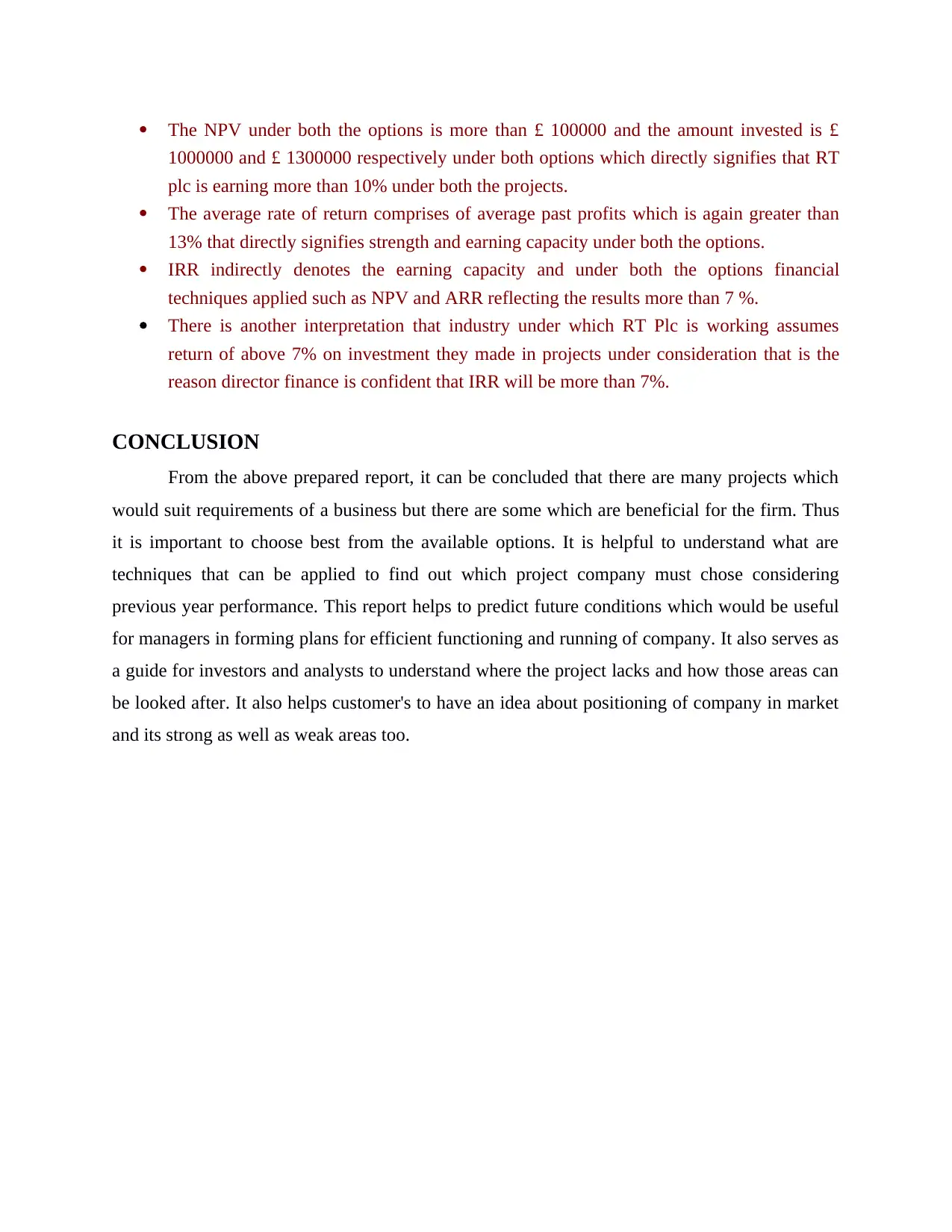
The NPV under both the options is more than £ 100000 and the amount invested is £
1000000 and £ 1300000 respectively under both options which directly signifies that RT
plc is earning more than 10% under both the projects.
The average rate of return comprises of average past profits which is again greater than
13% that directly signifies strength and earning capacity under both the options.
IRR indirectly denotes the earning capacity and under both the options financial
techniques applied such as NPV and ARR reflecting the results more than 7 %.
There is another interpretation that industry under which RT Plc is working assumes
return of above 7% on investment they made in projects under consideration that is the
reason director finance is confident that IRR will be more than 7%.
CONCLUSION
From the above prepared report, it can be concluded that there are many projects which
would suit requirements of a business but there are some which are beneficial for the firm. Thus
it is important to choose best from the available options. It is helpful to understand what are
techniques that can be applied to find out which project company must chose considering
previous year performance. This report helps to predict future conditions which would be useful
for managers in forming plans for efficient functioning and running of company. It also serves as
a guide for investors and analysts to understand where the project lacks and how those areas can
be looked after. It also helps customer's to have an idea about positioning of company in market
and its strong as well as weak areas too.
1000000 and £ 1300000 respectively under both options which directly signifies that RT
plc is earning more than 10% under both the projects.
The average rate of return comprises of average past profits which is again greater than
13% that directly signifies strength and earning capacity under both the options.
IRR indirectly denotes the earning capacity and under both the options financial
techniques applied such as NPV and ARR reflecting the results more than 7 %.
There is another interpretation that industry under which RT Plc is working assumes
return of above 7% on investment they made in projects under consideration that is the
reason director finance is confident that IRR will be more than 7%.
CONCLUSION
From the above prepared report, it can be concluded that there are many projects which
would suit requirements of a business but there are some which are beneficial for the firm. Thus
it is important to choose best from the available options. It is helpful to understand what are
techniques that can be applied to find out which project company must chose considering
previous year performance. This report helps to predict future conditions which would be useful
for managers in forming plans for efficient functioning and running of company. It also serves as
a guide for investors and analysts to understand where the project lacks and how those areas can
be looked after. It also helps customer's to have an idea about positioning of company in market
and its strong as well as weak areas too.
⊘ This is a preview!⊘
Do you want full access?
Subscribe today to unlock all pages.

Trusted by 1+ million students worldwide
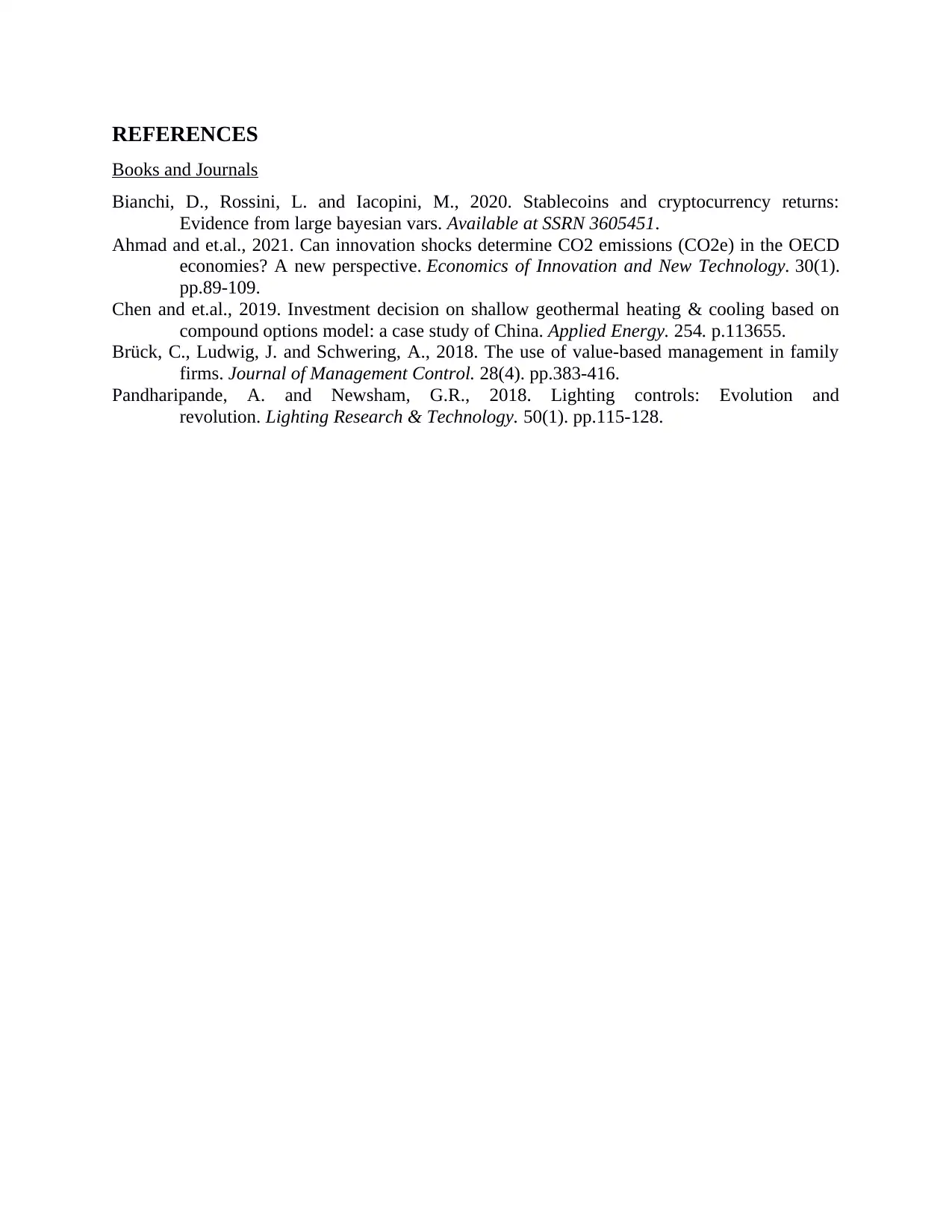
REFERENCES
Books and Journals
Bianchi, D., Rossini, L. and Iacopini, M., 2020. Stablecoins and cryptocurrency returns:
Evidence from large bayesian vars. Available at SSRN 3605451.
Ahmad and et.al., 2021. Can innovation shocks determine CO2 emissions (CO2e) in the OECD
economies? A new perspective. Economics of Innovation and New Technology. 30(1).
pp.89-109.
Chen and et.al., 2019. Investment decision on shallow geothermal heating & cooling based on
compound options model: a case study of China. Applied Energy. 254. p.113655.
Brück, C., Ludwig, J. and Schwering, A., 2018. The use of value-based management in family
firms. Journal of Management Control. 28(4). pp.383-416.
Pandharipande, A. and Newsham, G.R., 2018. Lighting controls: Evolution and
revolution. Lighting Research & Technology. 50(1). pp.115-128.
Books and Journals
Bianchi, D., Rossini, L. and Iacopini, M., 2020. Stablecoins and cryptocurrency returns:
Evidence from large bayesian vars. Available at SSRN 3605451.
Ahmad and et.al., 2021. Can innovation shocks determine CO2 emissions (CO2e) in the OECD
economies? A new perspective. Economics of Innovation and New Technology. 30(1).
pp.89-109.
Chen and et.al., 2019. Investment decision on shallow geothermal heating & cooling based on
compound options model: a case study of China. Applied Energy. 254. p.113655.
Brück, C., Ludwig, J. and Schwering, A., 2018. The use of value-based management in family
firms. Journal of Management Control. 28(4). pp.383-416.
Pandharipande, A. and Newsham, G.R., 2018. Lighting controls: Evolution and
revolution. Lighting Research & Technology. 50(1). pp.115-128.
Paraphrase This Document
Need a fresh take? Get an instant paraphrase of this document with our AI Paraphraser


⊘ This is a preview!⊘
Do you want full access?
Subscribe today to unlock all pages.

Trusted by 1+ million students worldwide
1 out of 9
Related Documents
Your All-in-One AI-Powered Toolkit for Academic Success.
+13062052269
info@desklib.com
Available 24*7 on WhatsApp / Email
![[object Object]](/_next/static/media/star-bottom.7253800d.svg)
Unlock your academic potential
Copyright © 2020–2025 A2Z Services. All Rights Reserved. Developed and managed by ZUCOL.



